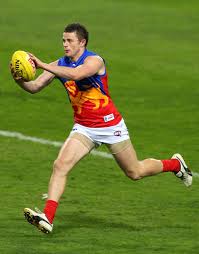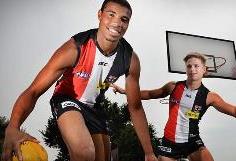Code Hoppers Making a Big Impact
- Friday, August 28 2015 @ 03:19 pm ACST
- Contributed by: Wesley Hull
- Views: 2,624



Arguably the biggest story in Australian sport this week was the amazing effort of former Parramatta Eels Rugby League player, Jarryd Hayne, bamboozling opponents in his new found code, American Football. In trying out for a contract with the San Francisco 49ers, his run, agility and power left experienced players in his wake and made the code’s recruiting people think that maybe there are more Aussies that possess the skills to succeed in the American national game.
In the days since his break-out game other potential Rugby-League and Rugby-Union players have been touted as the “next Hayne”.
Code-hopping in itself is not new. The AFL’s recent experiments with Karmichael Hunt and Israel Folou were well documented, though both ultimately fell short of their intention. They were local stories moving from one Australian code to another. But trying another code in another country is arguably harder. This is territory that past AFL players have dabbled in with Ben Graham, Sav Rocca and “Diamond Jim” Tilbrook some of the better known VFL/AFL players who have cracked the American national game.
But behind these examples lurks another potentially enormous code hop – internationally born and raised players leaving their own codes and countries to give the Australian game a go. Whilst the “Hayne Train” has succeeded in crossing the Pacific from Parramatta to San Francisco, there is a big wind blowing through the current AFL landscape which may yet top Hayne’s efforts.
This coming weekend there are five players lining up for AFL clubs who have journeyed far from home to play our game at its highest level. Jason Holmes (St Kilda - USA), Mike Pyke (Sydney - Canada), Pearce Hanley (Brisbane – Ireland), Conor McKenna (Essendon – Ireland) and Zac Tuohy (Carlton – Ireland) will take the field for their adopted clubs. Mason Cox (Collingwood – USA) was expected to be named for his debut, a week on from Holmes, but didn’t quite make the cut. Maybe next week.
This is an interesting statistic. It means that this weekend just over 1.25% of the 396 players that take the field for senior AFL games with the 18 national teams have code-hopped their way to the highest level of AFL football directly from overseas. Some will look at 1.25% and say – “proves nothing, that’s a tiny percentage”. If Cox does get picked next week, that figure will jump to 1.5% if the others are not dropped for their Round 23 matches. But ten years ago – maybe even five – people would have laughed loudly at the prospect of even one percent of AFL players coming directly to clubs from overseas. Half a percent would have got a decent chuckle and quarter of a percent would have elicited at least a crooked smile.
And these are just the players being selected for senior duties. There are many others, largely from the USA and Ireland, playing in the VFL. They are scattered across Geelong, Fremantle, West Coast. Half of the AFL clubs currently boast an international code-hopper and others have previously taken the plunge to varying degrees of success. Out of Ireland alone there have been 21 players reach a senior game with an AFL/VFL team since Sean Wight in 1982. In that time 33 others have signed with a VFL/AFL club without playing a senior match.
A few weeks ago the AFL celebrated the Multicultural Round where it recognised the diverse ethnic origins of players at all levels of the game. Players like Majak Daw, Adam Saad, Ahmed Saad, Nic Natanui, Jason Johannisen, Lin Jong and more were standard bearers for the ongoing wave of multicultural embracement of the game. But the deeds of the Hanley, Holmes, McKenna, Tuohy, Pyke quintet are more unique, and potentially more game-changing again.
This is a landmark round for the international future of Australian Rules football. Whether or not the clubs that cannot play finals are using the round for experiments might be why the spike in international players, but regardless the players are there. In the wings blokes like Sean Hurley at Fremantle, Paddy Brophy at West Coast, Alex Auricchio at the Northern Blues, Ciaran Sheehan and Ciaran Byrne at Carlton, Cian Hanley at Brisbane or Kurt Heatherley at Hawthorn will now see the task of reaching the highest level as more and more achievable.
More and more players have come to Australia and tried their luck with VFL and local league teams this year and more players from Basketball, American Football, Gaelic Football and overseas Australian Rules clubs are trying their luck at AFL endorsed talent combines to sell their wares and hope for that big break.
As more players see other countrymen realise their dreams, those dreams will transfer onto others.
There will always be the sceptics who will hear Andrew Demetriou’s words from a couple of years ago when he stated that our game is an “unashamedly” indigenous game to Australia. That may well remain true in many respects, but the influx of international talent, the growth of the game in many international markets and the recognition of local multicultural talent through the workings of the AFL’s own Diversity Unit fly a little in the face of that statement. This weekend’s selections for Round 22 teams are the strongest evidence yet that the tide is turning, maybe quicker than Demetriou or others had anticipated.
Whilst Gillon McLachlan’s recent speeches have skirted and danced around the edges of the international development of the game, and funding the game at an international level will always be a lower priority that grass roots development in Australia, the fact is that clubs are now seeing a viable international market. The pathways first trodden by the likes of Jim Stynes, Sean Wight or Tadhg Kennelly and considered a successful anomaly are now being trodden with more frequency by a new generation of interested players. And as long as players like Mike Pyke can win premiership medals, or Pearce Hanley can be a 2nd and 3rd placegetter in the Brisbane Lions best & fairest in consecutive years, there will be a growing belief that in another generation there will be more success.
If in ten years from now there was a jump to two percent of overseas players, that would be ten or so players. Three percent might be the equivalent of one player per club at AFL’s highest level.
It might even come to pass that arriving international players make the same impact on our code as Jarryd Hayne has just done in American football. Sceptics can be sceptics, but the evidence is mounting that international players will become more common and successful in Australian Rules football in years to come.
Who knows? Maybe all five players will be dropped for next weekend. But it doesn’t matter…the seeds of belief and success have already been planted. There’s no turning back now.


 RSS news
RSS news Twitter
Twitter Facebook
Facebook